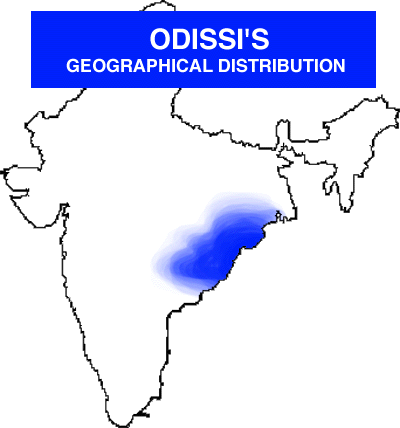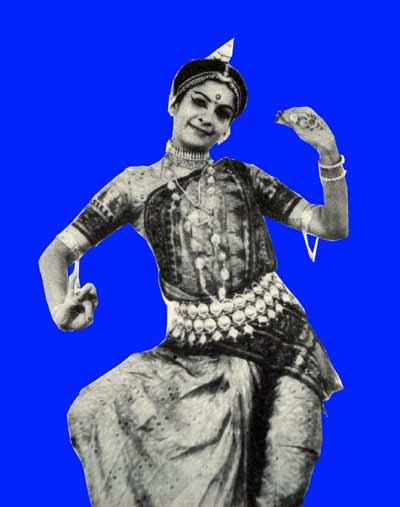The Odissi (Orissi) dance is the Indian classical dance from the Eastern state of Odissa. It has a long, yet broken tradition. Although dance in Odissa may be traced back more than 2000 years, it was brought to near extinction during the colonial period. Therefore, modern Odissi dance is a reconstruction.

History
Like other forms of Indian classical dance, the Odissi style traces its origins back to antiquity. Dancers are found depicted in bas-relief in the hills of Udaygiri (near Bhubaneshwar) dating back to the 1st century BC. The Natya Shastra speaks of the dance from this region and refers to it as Odra-Magadhi.
Over the centuries three schools of Odissi dance developed: Mahari, Nartaki, and Gotipua. The Mahari tradition is the devadasi tradition; this is the use of women who are attached to deities in the temple. The Nartaki tradition is the school of Odissi dance which developed in the royal courts. Gotipua is a style characteristed by the use of young boys dressed up in female clothing to perform female roles.
Odissi dance was held in high esteem before the 17th century. Nobility were known for their patronage of the arts, and it was not unheard of for royalty of both sexes to be accomplished dancers. However, after the 17th century, the social position of dancers began to decline. Dancing girls were considered to be little more than prostitutes, and the “Anti-Nautch” movement of the British brought Odissi dance to near extinction.
Before Independence, the position of Orissi dance was very bad. The tradition of dancing girls at the temple at Puri was abolished. The royal patronage of nartaki had been severely eroded by the absorption of India under the crown. The only viable Odissi tradition was the Gotipua. This had weathered the British Anti-Nautch movement simply because it was danced by males. Yet even the Gotipua tradition was in a very bad state.

Independence brought a major change in official attitudes toward Indian Dance. Like the other classical arts, dance was seen as a way to define India’s national identity. Governmental and non-governmental patronage increased. The few remaining Odissi dancers were given employment, and a massive job of reconstructing the Odissi dance began. This reconstruction involved combing through ancient texts, and more importantly, the close examination of dance posses represented in bas-relief in the various temples.
There were a number of people who were responsible for the reconstruction and popularisation of Odissi dance. Most notable are Guru Deba Prasad Das, Guru Mayadhar Raut, Guru Pankaj Charan Das, Guru Mahadev Rout, Guru Raghu Dutta, and Guru Kelu Charan Mahapatra.
Today Odissi dance is once again deemed a viable and “classical” dance.
Style
There are a number of characteristics of the Odissi dance. The style may be seen as a conglomeration of aesthetic and technical details.
One of the most characteristic features of Odissi dance is the Tribhangi. The concept of Tribhang divides the body into three parts, head, bust, and torso. Any posture which deals with these three elements is called tribhangi. This concept has created the very characteristic poses which are more contorted than found in other classical Indian dances.
The mudras are also important. The term mudra means “stamp” and is a hand position which signifies things. The use of mudras help tell a story in a manner similar to the hula of Hawaii.
Themes
The themes of Odissi are almost exclusively religious in nature. They most commonly revolve around Krishna. Although the worship of Krishna is found throughout India, there are local themes which are emphasised. The Ashtapadi’s of Jayadev are a very common theme.
Music
The musical accompaniment of Odissi dance is essentially the same as the music of Odissa itself. There are various views on how the music of the Odissi relates to the music of greater North India. It is usually considered just another flavour of Hindustani sangeet, however there are some who feel that Odissi should be considered a separate classical system.
There are a number of musical instruments used to accompany the Odissi dance. One of the most important is the pakhawaj, also known as the madal. This is the same pakhawaj that is used elsewhere in the north except for a few small changes. One difference is that the right head is a bit smaller than the usual north Indian pakhawaj. This necessitates a technique which in many ways is more like that of the tabla, or mridangam. Other instruments which are commonly used are the bansuri (bamboo flute), the manjira (metal cymbals), the sitar and the tanpura.
There was a move to classify Odissi as a separate classical system. This movement is generally considered to have failed for a number of reasons. The general view is that traditional Orissi singers and musicians have been so influenced by Hindustani concepts that they are unable to present the music in its “original” form.
There is a peculiar irony to this movement. Had they succeeded in having Odissi music declared to be a separate system, then it would be hard to justify calling it classical. It would fail to achieve any level, of ethnic transcendence and would essentially be reduced to the level of a “traditional” art form.
Selected Video
Other Sites of Interest
On Filming Classical Indian Dance
The Limits Of Orientalism: Classical Indian Dance And The Discourse Of Heritage
From interculturalism to historicism: reflections on classical Indian dance (2000/1)
Classical Indian Dance in Literature and the Arts Kapila Vatsyayan (Book Review)
From: Bodies that Matter: on the Discursive Limits of ‘sex'
The Theory and Technique of Classical Indian Dancing
From Interculturalism to Historicism: Reflections on Classical Indian Dance
Classical Indian Dance and Women’s Status
Bharata Natyam: A Classical Indian Dance in Transition
